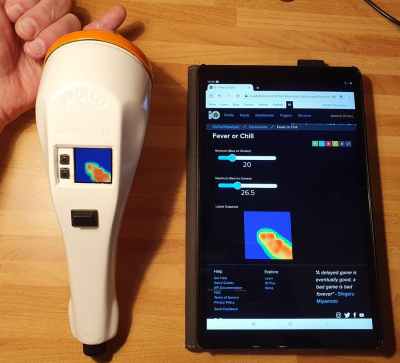[Tarik and Kemal] have an objective in mind: to drop a home-made autonomous glider from a high-altitude balloon and safely return it to home. To motivate them, [Tarik] has decided not to cut his hair until they reach 18,000 feet. Given the ambition of their project, it isn’t surprising that his hair is getting rather long now.
A Thermal Camera With A Vintage Twist
Nowadays we often value the superb design of vintage technology. It is, therefore, laudable when a broken piece of old electronics is given a new purpose. These types of builds are exactly [Martin Mander’s] cup of tea as he confirmed by turning a 1979 Apollo microwave monitor into a thermal camera (video embedded below).
Intrigued by its unique design, [Martin Mander] picked up the original microwave monitor at a secondhand sale, although the device was not exactly in mint condition. Supposedly this type of detector was used to monitor the exposure of personnel to microwave radiation in an industrial environment.
was not exactly in mint condition. Supposedly this type of detector was used to monitor the exposure of personnel to microwave radiation in an industrial environment.
After removing all the guts, he replaced them with a Raspberry Pi Zero W, Adafruit thermal camera, 1.3″ TFT display, and a USB battery pack. It is especially nice that [Martin Mander] was able to mount all the components without relying on 3D prints but instead, he hand-carved some custom panels and brackets from waste plastic.
The software is based on Python and automatically uploads the captured images to an Adafruit.IO dashboard. With 8 x 8 pixels the resolution of the sensor is not great but by using bicubic interpolation he was able to convert it to a 32 x 32 image which was enough to take some interesting pictures of his cat and other household items.
It is also worthwhile to check out some of [Martin Manders] other retro-tech mods like his cassette Pi IoT scroller.
Econet – Britain’s Early Educational Network
If you compare the early PC market for the US and the UK, you’ll notice one big difference. While many US schools had Apple computers, there were significant numbers of other computers in schools, as well. In the UK, pretty much every school that had a computer had an Acorn BBC Micro. [RetroBytes] takes us down memory lane, explaining how and why the schools went with Econet — an early network virtually unknown outside of the UK. You can see the video, which includes an interview with one of the Acorn engineers involved in Econet.
Nowadays, you don’t have to convince people of the value of a network, but back then it wasn’t a no brainer. The driver for most schools to adopt networking was to share a very expensive hard disk drive among computers. The network used RS-422, a common enough choice in Apple computers, spacecraft, and industrial control applications.
Continue reading “Econet – Britain’s Early Educational Network”
The Three Shell Mystery Finally Solved!
While we certainly acknowledge the valuable contributions of the open hardware community that help to mitigate the coronavirus crisis, we are also looking forward to the days when people start going back to building other things than 3D-printed face shields, pandemic trackers, and automatic soap dispensers. However, this handwash timer by [Agis Wichert] is a very creative version that also tries to solve the long outstanding mystery of how to use the three seashells. Unfortunately, in contrast to those in the original movie, these three seashells do not replace toilet paper which many people are seemingly so desperate in need of at the moment.
The build is quite simple and requires only a few off-the-shelf components including a Neopixel strip, IR proximity sensor, and an Arduino Nano. The plastic seashells were taken from the classic German “Schleckmuschel” candy, thereby giving the project an extra retro twist. As shown in the video embedded below, the timer works by consecutively dimming the LEDs located under each seashell until the recommended duration of 20 seconds has elapsed which is indicated by shortly flashing all LEDs.
Handwash timer projects do not always have to be visual as this one playing your favorite Spotify tunes proves. What we really would like to see though is someone building a toilet paper dispenser that is triggered by swearwords.
Automatic Timelapses, Made Educational And Easy

There are plenty of ways to create timelapse videos, but [Andy] has an efficient method for ensuring up-to-date ones exist for his infrared sky camera, and he has it running thanks to some well-documented shell scripts on a spare Raspberry Pi. The resulting timelapse video is always available from the web, and always up-to-date for the current day.
The idea is to automatically fetch images from a remote source (in his case, an infrared sky camera) and turn them into a cumulative video that is regularly updated for the day in question. The resulting video file is either served from the same machine, or sent elsewhere. All that’s needed besides a source for the stills are two shell scripts and some common Linux utilities.
Since [Andy] is mainly interested in tracking clouds his system only runs during daylight hours, but it can be easily changed. In fact, [Andy]’s two shell scripts are great project resources, not only because they are easily modified and well documented, but because he doesn’t make assumptions about how well one might know the command line. He also provides tips from experience; for example he has found that a 120 second interval makes for the best timelapses.
[Andy] runs his scripts on an Raspberry Pi 4, but any Linux system will do. For those who might prefer a more embedded approach, the ESP32-CAM can make a great time lapse camera with remarkably little effort.
Puttering Around In A Converted Golf Cart
Technically speaking, golf carts are already sports cars, they’re just not very sporty in themselves. When [rtkerth] went to trade in his old golf cart for a new one, he found that it would be more valuable to hang on to the old one and have a bit of fun with it. The result is retro-styled kart that would not look out of place at a micro car show.
Before getting to the really fun bits, he had to do a bit of prep work, such as relocating the six large batteries so that super cool stock seat can sit lower. Now the batteries are distributed throughout the vehicle, including one that’s been cleverly disguised as center console. Since the cart won’t be hitting the links anymore, there’s no need for a place to put clubs. Two of the batteries are now in the back, supported by a platform made from old bed frames.
We love the fiberglass fab work [rtkerth] did to the front and rear — it looks great, especially considering he’d never done it before. The rear is done more traditionally with a foam mold, but the front is fiberglassed directly over expanding foam insulation framed with cardboard. The local body shops refused to paint this baby roadster, so [rtkerth] did it himself before adding the killer touches — 1930s Brooklands-style windscreens and 1950s bullet mirrors that look great together.
Believe it or not, this isn’t the first amazing golf cart mod we’ve seen. Go see this baby DeLorean before you’re outta time.
As A Matter Of Fact, It’s All Dark
While the dark side of the moon wasn’t seen by humans until the middle of the 20th century, that side of the moon isn’t always dark, just hidden from view of Earth by a quirk of gravity. The more appropriate name for the other half of the moon is the “far side”, but while it gets just as much sunshine as the near side does it is dark to one thing in particular: man-made radio waves. That, along with the lack of an atmosphere and ionosphere on the moon, makes it a perfect place for a new telescope.
This telescope isn’t like something you’d set up in your back yard, either. It’s more similar to the Aricebo Observatory in Puerto Rico which uses natural topography to help form the telescope. The proposed telescope on the far side of the moon would use a robot to deploy a net along a fairly large crater to act as a parabolic dish, while another robot would suspend the receiver above the crater. The large size is necessary for viewing deep into space, but is also because of the low-frequency radio signals they hope to capture.
Building a dish like this on the moon is sure to be no easy task, especially since remote control on the far side of the moon is difficult for precisely the reasons that make this a good location for a telescope. But with an appropriate amount of funding and some sufficiently autonomous robots it should be possible. Plus, you never know what you’ll find when looking deep into space.

















